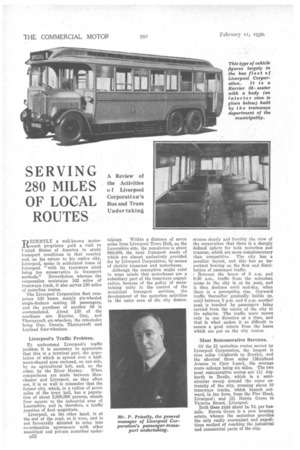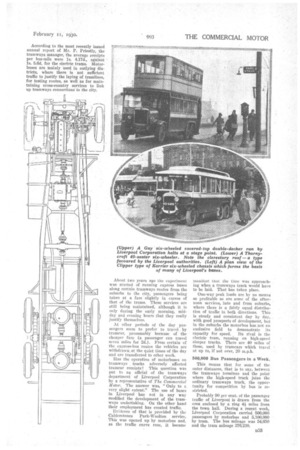SERVING 280 MILES OF LOCAL ROUTES
Page 146

Page 147

If you've noticed an error in this article please click here to report it so we can fix it.
RDECENTLY a well-known motorcoach proprietor paid a visit to Vnited States of America to study transport conditions in that country and, on his return to his native city, Liverpool, spoke in acidulated tones of Liverpool "with its tramways mind being too conservative in transport methods." Nevertheless, whereas the corporation maintains 162 miles of tramways track, it also serves 120 miles of motorbus routes.
The Liverpool Corporation fleet comprises 160 buses, mainly six-wheeled single-deckers seating 38 passengers, and the purchase of another 50 is contemplated. About 130 of the machines are Karrier, Guy, and Thornycroft six-wheelers, the remainder being Guy, Dennis, Thornycroft and Leyland four-wheelers.
Liverpool's Traffic Problem.
To understand Liverpool's traffic problem it is necessary to appreciate that this is a terminal port, the population of which is spread over a halfmoon-shaped area enclosed, on one side, by an agricultural belt, and, on the other, by the River Mersey. When comparisons are made between Manchester and Liverpool, as they often are, it is as well to remember that the former city, which, in a radius of seven miles of the town hall, has a population of about 2,500,000 persons, stands four square to the industrial area of Lancashire, and is, therefore, a traffic junction of first magnitude.
Liverpool, on the other hand, is at the end of the road, as it were, and is not favourably situated to enter into co-ordination agreements with other municipal and private motorbus under D52 takings. Within a distance of seven miles from Liverpool Town Hall, on the Lancashire side, the population is about 900,000, the local transport needs of which are almost exclusively provided for by Liverpool Corporation, by means of electric tramcars and motorbuses.
Although the conception might exist in some minds that motorbuses are a subsidiary part of the tramways organization, because of the policy of maintaining unity in the control of the municipal transport services, the development of the motorbus activities in the outer area of the city demon strates clearly and forcibly the view of the corporation that there is a sharply defined sphere for both motorbus and tramcar, which are more complementary than competitive. The city has a peculiar layout, and this has an important bearing on the flow and distribution of passenger traffic.
• Between the hours of 8 a.m. and 9.30 am., traffic from the suburban areas to the city is at its peak, and it then declines until mid-day, when there iS a perceptible rise. Outward traffic thereafter gradually builds up, until between 5 p.m. and 6 p.m. another peak is touched by passengers being carried from the centre of the city to the suburbs. The traffic wave moves only in one direction at a time, and that is what makes it so difficult to secure a good return from the buses which are put on the city routes.
Most Remunerative Services.
Of the 21 motorbus routes served by Liverpool Corporation, the longest is nine miles (Aigburth to Bootle), and the shortest three miles (Muirhead Avenue to Carr Lane), the average route mileage being six miles. The two most remunerative routes are (1) Aigburth to Bootle, which is a semicircular sweep around the outer extremity of the city, crossing about 10 tramways tracks, which branch outward, in fan form, from the Pier Head, Liverpool ; and (2) Norris Green to Victoria Street, Liverpool.
Both these yield about 1s. 7d. per busmile. Norris Green is a new housing estate, whence the motorbus provides the only really convenient and expeditious method of reaching the industrial and commercial parts of the city. About two years ago the experiment was started of running express buses along certain tramways routes from the suburbs to the city, passengers being taken at a fare slightly in excess of that of the trams. These services are still being maintained, although it is only during the early morning, midday and evening hours that they really justify themselves.
At other periods of the day passengers seem to prefer to travel by tramcar, presumably because of the cheaper fare (a passenger can travel seven miles for 2d.). From certain of the express-bus routes the vehicles are withdrawn.at the quiet times of the day and are transferred to other. work. Has the operation a motorbuses on tramways . tracks adversely affected tramcar receipts? This question was put to an official of the tramways' department of Liverpool Corporation by a representative of The Commercial Motor. The answer was, "Only to a very slight extent." The use of buses in Liverpool has not in any way modified the development of the tramways undertaking. On the other hand their employment has created traffic.
Evidence of that is provided by the Calderstones Park-Woolton service. This was opened up by motorbus and, as the traffic curve rose, it became manifest that the time was approaching when a tramways track would have to be laid. That has taken place.
One-way peak loads are by no means so profitable as are some of the after. noon services, into and from suburbs, where there is a fairly equal distribution of traffic in both directions. This is steady and consistent day by day, with good prospects of development, but in the suburbs the motorbus has not an exclusive field to demonstrate its capacity for speed. Its rival is the electric tram, running on high-speed sleeper tracks. There are 40 miles of these, used by tramcars which travel at up to, if not over, 20 m.p.h.
500,000 Bus Passengers in a Week.
This means that for some of the outer distances, that is to say, between the tramways terminus and the point where the high-speed track joins the ordinary tramways track, the opportunity for competition by bus is restricted.
Probably 90 per cent. of the passenger traffic of Liverpool is drawn from the area enclosed by a ring 4i miles from the town hall. During a recent week, Liverpool Corporation carried 500,000 passengers by motorbus and 5,100,000 by tram. The bus mileage was 54,650 and the tram mileage 376,230.




























































































































































































































